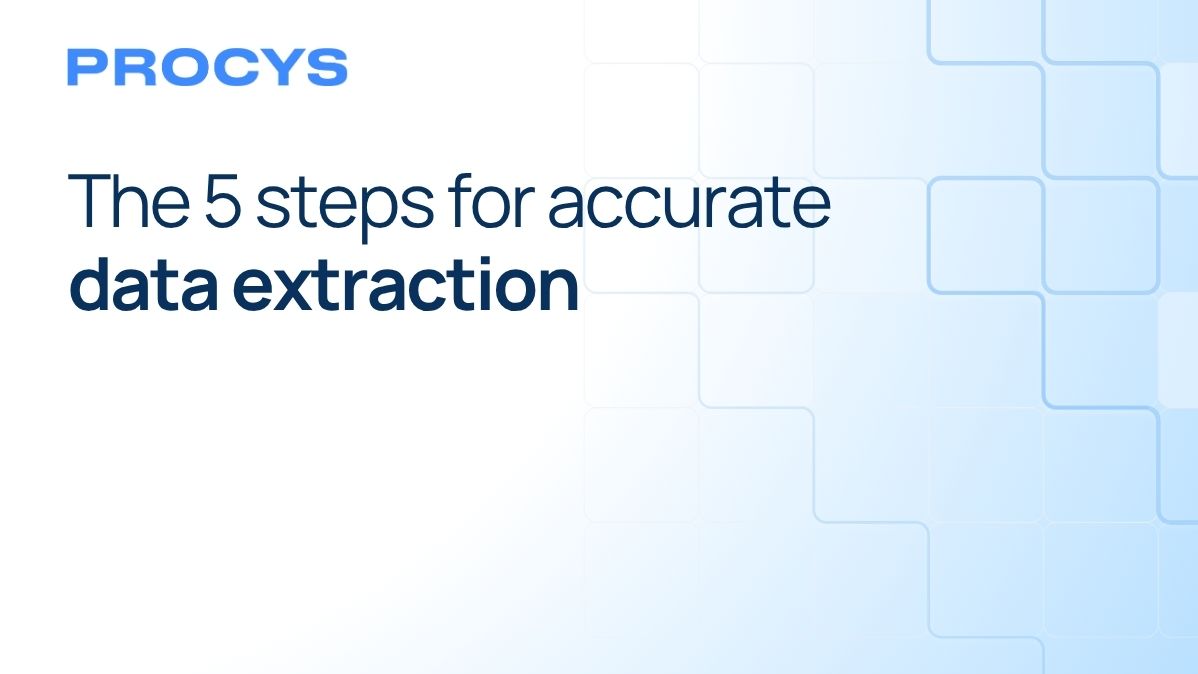The 5 steps for accurate data extraction
Accurate data extraction is crucial for businesses drowning in documents - now is the time to streamline and accelerate.

According to studies, office workers spend about 10% of their day on tasks like updating ERP systems, CRM platforms, or spreadsheets, much of which involves creating or updating documents such as PDFs, spreadsheets, or Word files.
Accurate data extraction is crucial for businesses drowning in documents - now is the time to streamline and accelerate.
Common challenges to consider
By understanding the common challenges first, you can plan ahead and maximize the benefits of automated data extraction.
Even with the best tools, businesses often face obstacles:
- Poor scan quality – use preprocessing and OCR to improve input accuracy
- Diverse document formats – hybrid AI-template extraction handles variation efficiently
- Regulatory compliance – validation rules and audit trails help maintain compliance
- Scaling issues – continuous monitoring and retraining allow systems to grow with your business
Now that you understand the challenges, these steps will guide you to reliable, accurate data extraction every time.
Step 1: Identify and prioritize data sources
The first step in any data extraction project is understanding what you’re working with. Not all documents are created equal.
Start by mapping out your document landscape:
- Invoices – invoice numbers, totals, tax amounts, vendor details
- Purchase orders – item codes, quantities, pricing
- Receipts and contracts – dates, payment terms, key clauses
Prioritize the fields and document types that are mission-critical: for instance, invoice data extraction might be a core priority for accounting teams This prevents wasted effort on irrelevant data and ensures the most valuable information is captured accurately.
Pro tip: conduct a small audit of your typical documents to identify patterns and recurring fields. This will help you define extraction priorities before investing in automation tools.
Step 2: Choose the right data extraction tools
The effectiveness of your data extraction depends on selecting tools that match your document types and business needs.
Traditional template-based tools can struggle with diverse document layouts. Modern platforms, like Procys, combine multiple approaches:
- Template-based extraction for highly structured documents
- Machine learning and AI for contextual understanding
- Hybrid approaches for documents that vary in format or language
Selecting the right tool is critical for scaling accuracy. Look for features such as OCR (optical character recognition) for scanned documents, support for multiple file formats (PDFs, images, spreadsheets), and the ability to learn from corrections over time.
Pro tip: test tools on a sample of your real-world documents to see which extracts the highest accuracy before committing.
Step 3: Data cleansing and preparation
Even the smartest tool struggles with messy inputs. Poor scan quality, inconsistent formats, or missing information can drastically reduce extraction accuracy.
Steps to prepare your data:
- Convert scanned images into readable text using OCR
- Standardize formats for dates, currencies, and addresses
- Remove duplicate documents or irrelevant pages
- Correct skewed scans or faded text
Pre-processing ensures that your extraction system has a clean, consistent input - which directly translates to higher accuracy and less manual correction.
Pro tip: to process complex documents, refer to custom data extraction functions
Step 4: Data integration and storage
Extracted data is only useful if it can be integrated into your workflows.
With advanced, pre-built integrations, you can:
- Connect outputs to accounting, ERP, or CRM systems
- Store data in structured formats for easy reporting
- Apply validation rules to catch anomalies, such as totals not matching line items or incorrect tax rates
Integration also enables automation. For example, invoice totals can automatically update your accounts payable, or purchase order data can feed inventory management systems.
Proper storage and integration reduce errors and make auditing simpler.
Example: Procys allows businesses to extract invoices, digitize purchase orders, and other documents in one platform, while feeding clean data directly into existing systems for immediate use.
Step 5: Continuous monitoring and updating
Data extraction isn’t a one-time project. To maintain accuracy as your documents and workflows evolve:
- Monitor extraction performance over time
- Retrain AI models with new document types
- Update validation rules to reflect regulatory changes or new business requirements
Continuous monitoring ensures your automation adapts to real-world variations and improves over time, ultimately reducing manual oversight.
Outcome: Faster reporting cycles, fewer errors, and less stress during audits.
How Procys helps
Procys is designed to tackle the exact pain points of modern businesses:
- One easy platform – handle invoices, purchase orders, and other documents in one place
- Full automation – extract data across formats in seconds
- Compliance-ready – maintain clean, validated data and stay audit-ready
With Procys, businesses avoid drowning in paperwork, reclaim time, and unlock true operational efficiency.
Test our platform for yourself today for free - sign up here (no credit card required)


.png)

.png)